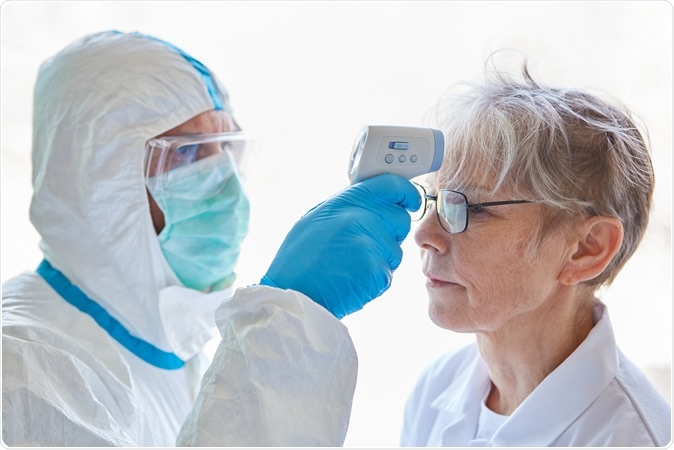With the spread of COVID-19 all over the world, causing over 1.5 million cases and over 95,000 deaths so far, many countries have enacted social distancing measures to reduce the transmission rate and bring down the mortality as quickly as possible. Such measures consist basically of keeping infected people away from those who are not, primarily due to the absence of a vaccine.
As a result of these measures, public health authorities hope to ‘flatten the curve’ of the epidemic. However, once these are rescinded, the virus will resume its uninterrupted spread, fear many experts.
At present, most tests are taking place within hospitals, within the UK as well as in many other countries. Thus, the number of reported cases is mostly parallel to the number of symptomatic cases. However, the true number of infected asymptomatic people is still unknown – nor is the risk of transmission due to these cases. These numbers may hold the key to understanding the true risk of transmissibility.

Measuring forehead by infrared for COVID-19. Study: COVID-19: four fifths of cases are asymptomatic, China figures indicate. Image Credit: Robert Kneschke / Shutterstock
The study
The study is based on a compilation of Chinese data published by the authorities there from April 1, reporting the number of new but asymptomatic coronavirus cases. They stated that 130 of 166 new cases (78%) detected over a 24-hour period up to the afternoon of April 1 were asymptomatic. The 36 symptomatic cases “involved arrivals from overseas,” as per the National Health Commission of China. Moreover, the South China Morning Post cites classified sources to indicate the finding of over 43,000 cases of asymptomatic infection through contact tracing. These cases are being kept in isolation, along with their contacts, to prevent another wave of infections.
The current study suggests findings that are quite different from earlier studies. For example, a reading of the situation on the ship Diamond Princess showed that only about 113 (18%) of infected people were totally asymptomatic. In another study of the Japanese evacuees from Wuhan, only a third were asymptomatic despite being positive. Most earlier epidemics have caused symptomatic and, therefore, readily detectable infections.
The WHO said in February of this year that asymptomatic infections “appears to be relatively rare and does not appear to be a major driver of transmission.” However, a recent WHO report states that among infected people, 80% are asymptomatic or have mild symptoms. The exact split between mild and no symptoms is unclear, however, as is the basis on which the asymptomatic cases were identified.
The current study also cites research from Vo, an isolated village of about 3,000 in Italy. Blanket testing was followed by the isolation of symptomatic as well as asymptomatic positives. This brought down the rate of positives by about 90% over ten days, from 3% of the population to 1%.
Immunologist Sergio Romagnani concluded that this shows that anywhere from 50% to 75% of infected cases showed no symptoms, while still being able to spread the virus freely. Another study in Iceland based on a widespread testing effort also supports the view that at least half the positives are asymptomatic. In stark contrast, most testing taking place in other parts of the world today is confined to people who have symptoms suggestive of coronavirus infection and go into hospital.
How the researchers did their calculations
Mathematical models are a powerful way to simulate a situation using math formulas and conditions that reflect the state of knowledge about virus transmission and generate reliable forecasts about the future course of the pandemic.
This type of modeling should include the susceptible population, the exposed population, the infected population, and the recovered population. The infected population subgroup should be identified as symptomatic and asymptomatic, in turn, to be included separately in the model. No current model includes all these parameters accurately because of the large amount of uncertainty about the numbers in this group.
For instance, all current models use data from people who have tested positive for the virus after developing symptoms. If asymptomatic people do indeed make up a vast majority of such infections, the modeling framework must be rethought. For one, the case fatality ratio would look quite different, because of the huge number added to the denominator (number of infected people).
Secondly, not much is known about how long an asymptomatic case remains so before displaying symptoms – another important modeling parameter. While a Singapore study suggests a gap of 1-3 days, this must be confirmed, in which case it will significantly add to the quality of modeling.
This is where the new study will need supporting information in the form of actual testing, either for the virus or better, from antibody testing. This data could help to frame better and more reliable modeling frameworks, which can, in turn, provide more reliable predictions that are of actual use to health authorities.
The final word will be available only much later when antibody testing for SARS-CoV-2 becomes widespread. Such tests are a long way off at present but could inform decisions on social distancing extensions. If much of the population is already immune, for instance, restrictions on social mixing could be lifted earlier due to herd immunity. However, if the tests show a large pool of non-immune people, the measures would have to be continued much longer until an effective vaccine is found and has been effectively administered to at-risk groups, at least.
Source:
Journal references: